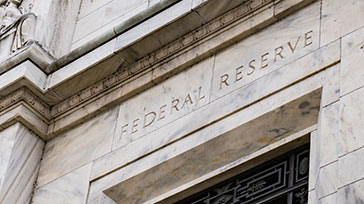Key Points
- S&P finally broke out of recent rangebound trading to hit new high
- Investors shrugged off inflation concerns ahead of Fed's meeting this week
- Europe's moment to shine with economies poise for economic upswing
The S&P 500 index ended the week (7-11 June) at a new high with a weekly gain of 0.4% for a third positive week with the Nasdaq Composite advancing 1.9% for a fourth winning week while the 30-stock Dow ended 0.8% lower for the week.
The small-cap Russell 2000 outperformed other indices rising by 2.2%. Sector-wise, REITs topped the week (+2%) followed by healthcare (+1.9%) and consumer discretionary (+1.6%).
Markets had built on the momentum following Wall Street’s gains on Thursday which saw investors shrugging off the May CPI rise of 5%, its quickest annualised increase since 2008.
With the 10-year bond yield slipping below 1.43% from as high as 1.77% earlier in the year, it would appear that investors are slowly cottoning on to the Fed’s mantra of inflation being “transitory.”
The uptick in sentiments was also felt across the Atlantic with the Stoxx Europe 600 closing up 0.7% to hit another record for a fourth advancing week after upgrades to growth forecasts for the Eurozone by the European Central Bank (ECB). It was the same with the London FTSE 100 index which registered its best weekly gain since early May.
European markets which are less reliant on shares of high-growth tech companies appear poised for breakouts in value and financial stocks which tend to perform well during upcycles, especially those that pay healthy dividends to shareholders.
Meanwhile, the latest data from the OECD showed most G20 economies returning to pre-pandemic levels in the first quarter of 2021, growing 3.4% on year compared to a 0.7% contraction the previous quarter.
China which was the first to be struck by the coronavirus registered the highest annualised growth in GDP (+18.3%) while India (+2.1%) and Turkey (+1.7%) continued to recover in the first quarter of 2021 as were Australia, South Korea and Brazil.
With economic data improving on multiple fronts, investors will be watching what central banks may do next such as pulling back on policies if economies start to overheat. However, there had been reassurances aplenty from policymakers including the Fed who has maintained that inflation is transient. Even China’s central bank governor stepped into the fray to comment that price levels are “generally under control” and should continue with “normal monetary policy.”
Which is why the Fed’s two-day meeting this week will be closely watched for comments on bonds purchases which had propped markets with its infusion of liquidity. A cutback in the Fed’s $120 billion monthly bond purchases would signal a shift in policy from quantitative easing to tightening.
The US central bank had said it expects inflation to be high momentarily before falling closer to 2% and had forecast that core inflation – measured by the personal consumption expenditures (PCE) price index – will be at 2% in 2022 and 2.1% in 2023.
Most economists who viewed the 5% uptick in the May CPI as a temporary reaction to post-pandemic reopening due to supply bottlenecks and resets in the US labour market do not expect any rate hikes unless core inflation stays persistently above 3.5%.
Other US data this week which may show clues of the trajectories for inflation and economic growth include the producer price index (PPI) and retail sales. The Fed will also release its industrial production index data which covers production and capacity in manufacturing, mining and other industries.
Over in Asia, investors will be looking at key data out of China this week including industrial production, retail sales, jobless numbers and fixed asset investment for May to assess if the pace of growth is moderating.
Domestic deadlock on the US infrastructure plans despite hints that the Biden administration is willing to relent on corporate tax rises will likely take a back seat this week due to President Joe Biden’s trip to the G7 summit in Europe which include discussions on how to counter China’s influence, followed by a meeting with Russian President Vladimir Putin in Geneva.
It may take some time for investors to digest the headline news before making any palpable risk-on moves.
This publication shall not be copied or disseminated, or relied upon by any person for whatever purpose. The information herein is given on a general basis without obligation and is strictly for information only. This publication is not an offer, solicitation, recommendation or advice to buy or sell any investment product, including any collective investment schemes or shares of companies mentioned within. Although every reasonable care has been taken to ensure the accuracy and objectivity of the information contained in this publication, UOB Asset Management Ltd ("UOBAM") and its employees shall not be held liable for any error, inaccuracy and/or omission, howsoever caused, or for any decision or action taken based on views expressed or information in this publication. The information contained in this publication, including any data, projections and underlying assumptions are based upon certain assumptions, management forecasts and analysis of information available and reflects prevailing conditions and our views as of the date of this publication, all of which are subject to change at any time without notice. Please note that the graphs, charts, formulae or other devices set out or referred to in this document cannot, in and of itself, be used to determine and will not assist any person in deciding which investment product to buy or sell, or when to buy or sell an investment product. UOBAM does not warrant the accuracy, adequacy, timeliness or completeness of the information herein for any particular purpose, and expressly disclaims liability for any error, inaccuracy or omission. Any opinion, projection and other forward-looking statement regarding future events or performance of, including but not limited to, countries, markets or companies is not necessarily indicative of, and may differ from actual events or results. Nothing in this publication constitutes accounting, legal, regulatory, tax or other advice. The information herein has no regard to the specific objectives, financial situation and particular needs of any specific person. You may wish to seek advice from a professional or an independent financial adviser about the issues discussed herein or before investing in any investment or insurance product. Should you choose not to seek such advice, you should consider carefully whether the investment or insurance product in question is suitable for you.





